Text



Echinodermata Patiria miniata, the bat star.
This five limbed echinoderm was found along the coast of Northern California. Bat stars, aptly names for the webbing that connects their short arms, are typically found in kelp forests or, like this specimen, attached to substrate in tide pools. Their range of living stretches along the North American coast from all the way in Sitka, Alaska and down to Baja, California. These scavengers use their tube feet, as observed to be moving in the video, in order to crawl around in search of any living or dead plants or animals to turn into a tasty meal! Their role as scavengers holds vital importance to their greater ecosystems as they act as janitors; cleaning up dead animal and algae matter. These little critters are susceptible to sea star wasting disease, a worrying condition that is potentially tied to the warming of ocean temperatures.
0 notes
Text
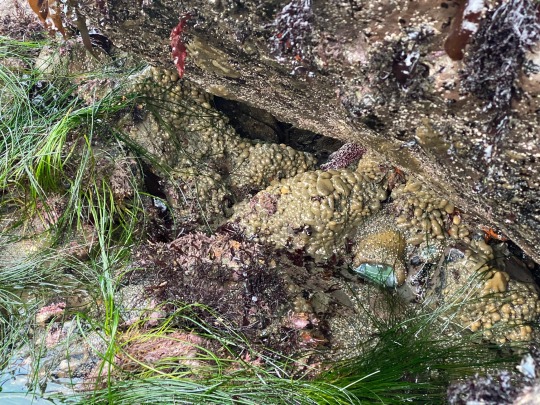
Colonial tunicate, or sea squirt, congregating on a rocky tidal substrate on the Northern California coast. These small filter feeders gather in dense groupings where their bodies are surrounded by tough tunic which forms from carbohydrates and proteins. They are commonly called “sea squirt” as they will squirt out sea water when touched.
0 notes
Text
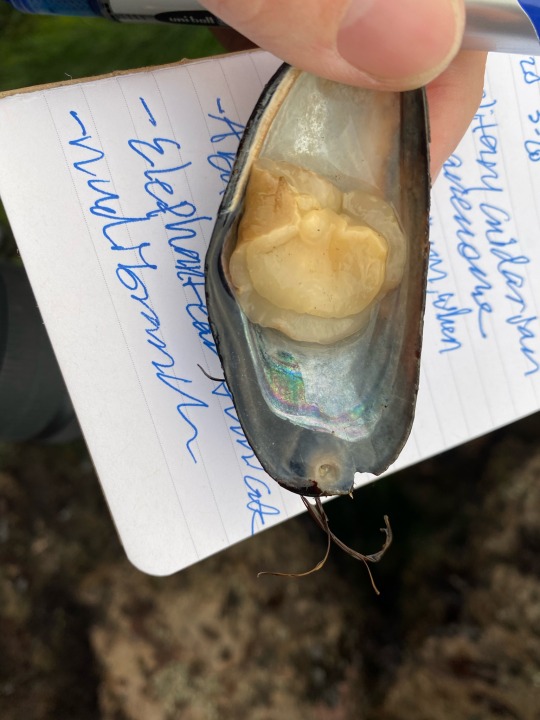
This Mollusca Gastropoda is from the order Nudibranchia, commonly known as a Nudibranch. This small nudibranch was found on the Northern California coast, hanging out on a shell. While most nudibranchs are noted for the vibrant, colorful patterns on their bodies, this nudibranch was a rather… nude-ibranch (ba-dum-ts). During their larval stage, they lose their vestigial shell, leaving them soft-bodied as seen here. Nudibranchs are hermaphroditic, which for them, means they aren’t too picky about who they fool around with; once they’re in the mood and come across any other nudibranch, it’s time for some true love! Other times though…. they may eat their fellow Gastropoda comrades. Nudibranch are carnivorous, with a diet of sponges, coral, anemones, barnacles, hydroids, eggs, sea slugs … and yes, other nudibranchs. In today’s world, habitat loss and degradation, pollution and overfishing pose the largest threats to these slimy, cannibalistic hermaphrodites.
0 notes
Text
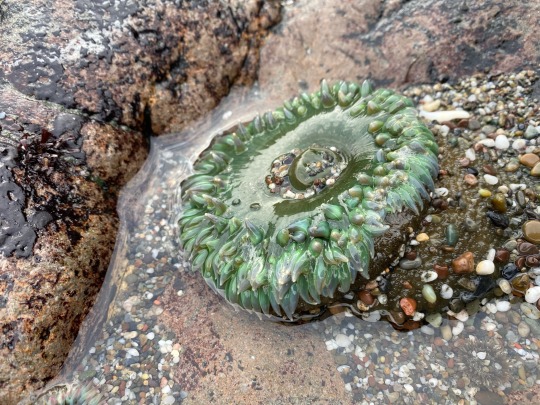
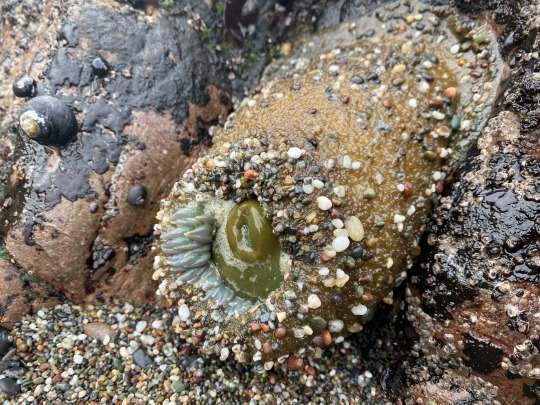

Cnidaria Anthozoa Sea Anenome. These predatory marine animals can be found all over the world but are most abundant in shallow, tropical waters. This specific individual was found connected to a rocky intertidal substrate in Northern California. As seen in these photos, the sea anenome has many tentacles surrounding its mouth area. These tentacles serve as excellent tools in order to capture any prey that might come into its reach. Typically, these anenome will feed on small fish, snails, limpets, crabs, really anything small and tasty enough to have the misfortune of falling into its slimy grip! Once secured, the sea anenome’s tentacles have stinging cells called nematocysts, assisting to paralyze the prey with a venom. Those tentacles will then slowly draw the prey into the anenome’s mouth, devouring it. As seen in the second and third photos, the sea anenome has a remarkable ability of closing itself into its body when exposed to air or disturbed. This individual was disturbed by a human finger, prompting it to close up; a nonverbal “Hey! Leave me alone jerk!” Sea anenome’s tentacles can also serve as a line of defense against predators such as nudibranchs, sea stars and some fish. Furthermore, they contain tentacles called acrorhagi which are specifically used for fighting when defending their territory. These tentacles are white tipped and can be seen in the third photo.
2 notes
·
View notes
Text

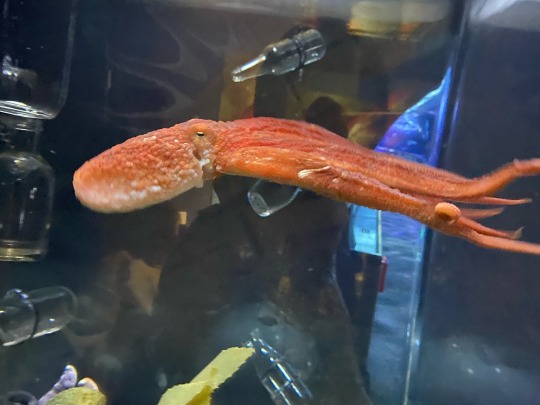
Enteroctopus dofleini, the giant pacific octopus. This cephalopod can be found around the North Pacific of California, British Columbia, Washington and Oregon; as well as Alaska, Russia, Japan and Korea. This particular individual seems to be a juvenile, as adults can weigh anywhere from 110lbs-600lbs. This individual was much smaller and found at the Aquarium of the Bay in San Francisco, CA. This photo set reveals one of the more remarkable features of this cephalopod, which is its unique pigment changing ability. The cells responsible for this color change are called chromatophores (pictures #1 and #2 are of the same octopus). This octopus has 8 arms, which it uses its suction cups to navigate the sea floor and substrate and to hunt prey; the males also have a special arm used to deposit sperm into the female. Typically, these predacious cephalopods hunt shrimp, clams, lobster and fish but some have been reported to eat sharks and birds. These creatures are sensitive to environmental changes, especially high levels of pollution.
0 notes
Text
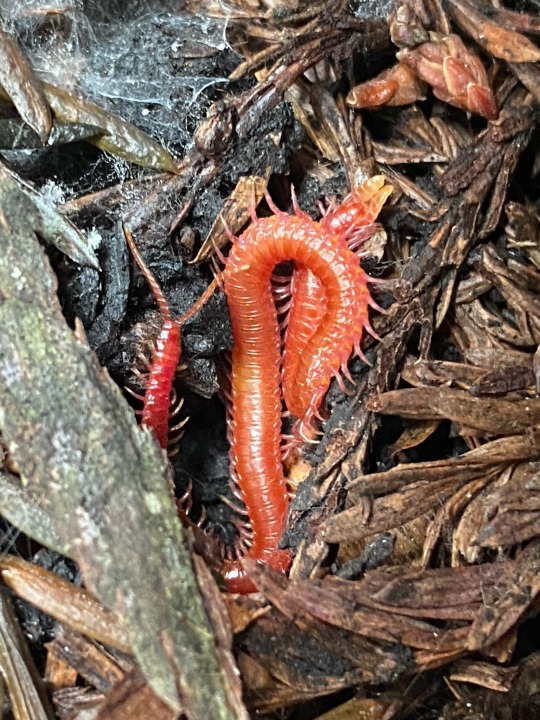
Cryptosporidium hortensis, or the Common Cryptops. This specimen was found in Sugarloaf State Park in Northern California. While typically a night hunter, I disrupted this creatures peace during the day by lifting up a rock that it was hiding under. This predator has venomous jaws that it uses to kill its prey, which can consist of spiders, flies, cockroaches and silverfish. Noted for their poor eye sight, this creature heavily relies on the use of its antennae to feel its way around, which can clearly be seen in the picture and video!
0 notes
Text

Arthropoda Hemiptera Notonecta maculata
This live specimen was caught by my fiancé in a creek within Annadel state park in Northern California. It had 4 limbs towards the anterior of the body, along with two very long limbs just behind those first set of 4. The long limbs were used as powerful “kickers” to help propel it under water, making it very difficult for my fiancé to catch; but she was determined! I took a video of it swimming around this container, but unfortunately my phone automatically deleted the video; if I can retrieve it I will be sure to add it here.
0 notes
Text

Dendronephthya Carnation.
This species of coral was found at the California academy of science, unfortunately I was unable to take down its exact name, so this is my best guess. The corals stem is anchored to the imitated sea floor, where it’s branches reach up and wave around the water. It’s remarkably beautiful in its vein like branching structure atop its thick stalk.
0 notes
Photo
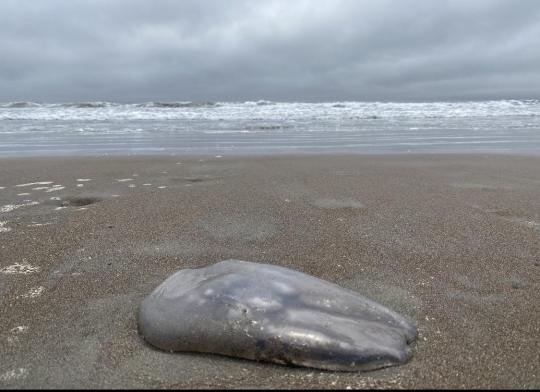
Cnidaria Scyphozoa Unfortunately, this is another classification I’m a bit unsure of, as this specimen was found dead, beached at Stinson Beach in Northern CA. Upon inspection of its dorsal region, there seemed to be solid interior anatomical structures, which further leads me to suspect that it’s a true jellyfish.
0 notes
Text

Arthropoda Arachnida Seatoda S. triangulosa.
This is the best taxonomic description I could find for this spider, though I still find myself to be unsure of who they could really be. Found in the Annadel Redwood park in Northern California, this spider was standing on its web; which was suspended within a plant. Upon irritating the spider with a stick, it displayed sudden and quick movements to avoid the object, but overall seemed docile and in a resting position.
1 note
·
View note
Text

Echinodermata Asteroidea Pisater P. brevispinus.
This large sea star had ordered anchored around a pole at the California Academy of Science. It stayed very still and did not display much movement upon observation. As seen here, it uses its 5 limbs to anchor around the substrate.
0 notes
Text

Common eastern bumble bee
(Bombus impatiens)
This is an interesting view of a large group of bumble bees found at the California Academy of Science. These animals were all swarming around this hive like structure that they share, typically crawling around or atop one another. They would crawl around with their 6 legs and at times, take flight, only briefly in this exhibit though.
0 notes
Text
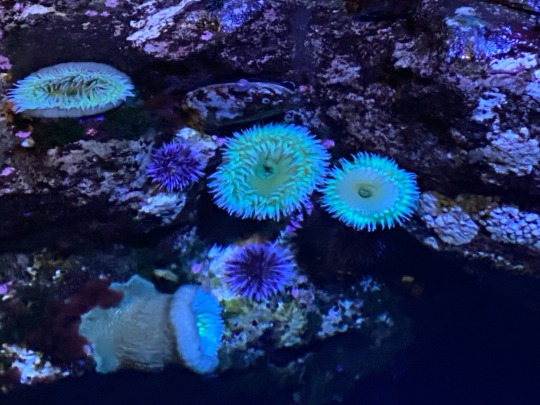
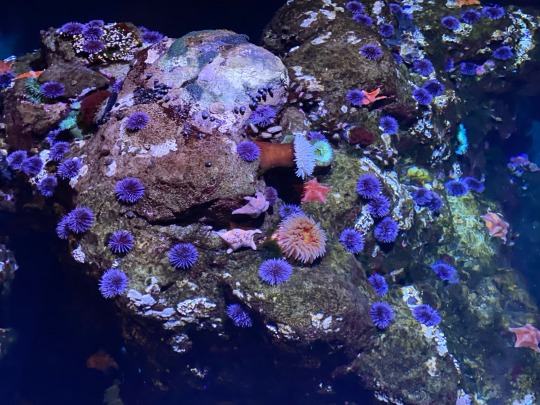
Cnidaria Anthozoa Actiniidae Anthopleura & Echinodermata Echinoida Strongylocentrotus purpuratus & Echinodermata Asteroidea Valvatida Patritia P. miniata.
These photos are extremely exciting to me, as we get the opportunity to observe three different species sharing one large space together. All of these animals were located at the Academy of Science in San Francisco and are abundant along the central California coast and as seen here, have themselves anchored to the substrate provided by the museum, imitating what would be the intertidal zone. On observation, they did not display much movement or activity.
0 notes
Text



Gastropoda Aplysiidae Phyllaplysia Phyllaplysia taylori, or the Eelgrass sea hare or Taylor’s sea hare.
I couldn’t help but include this unique Gastropod that we had observed in lab. It’s fantastically intricate markings and vibrant yellow and green colors had me enamored at first sight. This fellow moves along with its muscle foot, in the water it was particularly keen on climbing up the wall of its container to poke its head above the surface, but then submerge in retreat. Its two rhinophores would move independently from each other which was fascinating, I also observed an interior green cylindrical structure on the anterior of the animal. I’m assuming this to be its brain perhaps? I would be interested to observe how this animal feeds.
0 notes
Text

Arthropoda Insecta Hymenoptera Anthophila Colletidae.
This bee was found dead at my home in Northern Santa Rosa; my fiancé had excitingly pointed it out to me as she noticed it’s pollen sacs to be intact and full of pollen. An unfortunate fallen soldier who had failed its mission; perhaps by the hand (-er paw) of one of our feline roommates! Chances are that, before this bee perished, it was collecting pollen from our many flowers that we have on our deck. This ventral viewpoint makes it easy to see this bees 6 legs and two wings, as well as a view of its eyes and anterior antennae.
0 notes
Text

Orthoptera Tettigoniidae, or the Katydid.
This insect was found outside of my home in Santa Rosa CA. I observed it for a good long while in person and through my home security camera, and unfortunately for my notes, it displayed very little movement/observational behavior. It has a remarkable body plan that makes it look similar to a leaf, which is what I had initially mistaken it for! You can imagine my pleasant surprise once I noticed two beady eyes staring back at me!
0 notes
Text


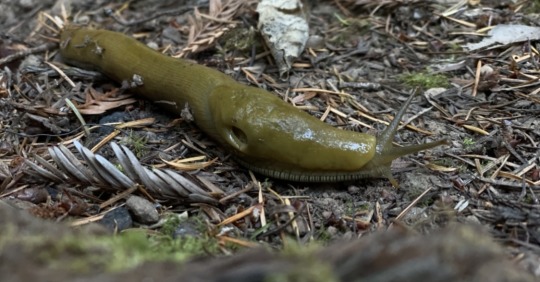

Lophozoa Molusca Gastropoda Ariolimax columbianus (and two excited homosapiens).
This particular banana slug was found in Northern California within the boundaries of Muir Woods. It is slow moving, traversing dense detritus with it’s muscular foot. The creature wasn’t very shy around us, as displayed in the selfie.
One of my favorite things about these photos is that you get a great view of the pneumostome of the slug in the 3rd picture, giving us visual insight to one of the creatures most important anatomical features; being that the pneumostome typically hides the respiratory pore, lung, reproductive organs and anus. Also interesting to note but not seen in these photos is the mucus-y trail left in this animals wake.
1 note
·
View note